Exhibited.
The Performance Space, Sydney, 1987.
Materials.
Section 1. Pipe element: Rough sawn Oregon timber, Plywood, Steel fittings and industrial turbine.
Section 2. Fan corridor: x 2 industrial turbines on timber mounts.
Section 3. Bell element: Raw clay over wood and expanded metal armature, with plywood mould board attached.
Dimensions.
Section 1: – 7m x 2m x 1.5m.
Section 2: – 2m x 2m x 1m (each unit).
Section 3: – 3.5m x 3m dia.
Notes.
A Symphony for Other Cultures contained the first of my large bell structures. The work was constructed to relate site-specifically to The Performance Space galleries and contained, in the first space, a giant industrial organ pipe (7m x 2m x 1.5m) tuned to 25Hertz and operating with a massive amplitude; in the cross-walk, two industrial turbines forcing air at high speed across the viewer/auditors path, and in the final gallery a huge silent bell form, fashioned of cracked adobe.
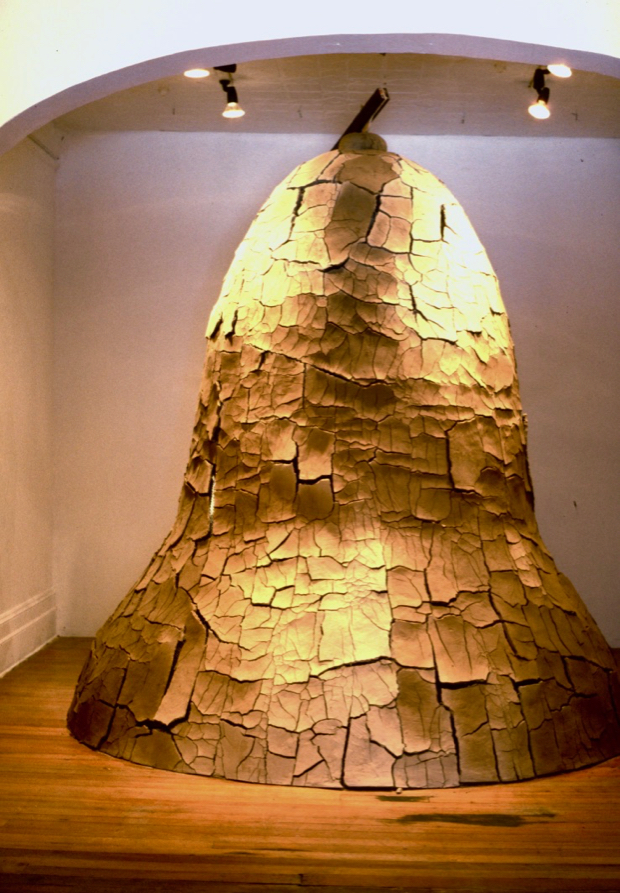
I would like to focus on the organ pipe. The essential point of making this instrument was that both its frequency (with a fundamental only just above the threshold of hearing) and its enormous amplitude (volume), which literally shook the building, was first and foremost an experience for the whole body, manifest as a singular event (i.e. located in one space and at one time). The signal could not be recorded, could not be transmitted or reproduced; so within the prevailing post-modern conditions of reproduction, quotation and repetition this pipe formed a resistant benchmark located in the unique event.
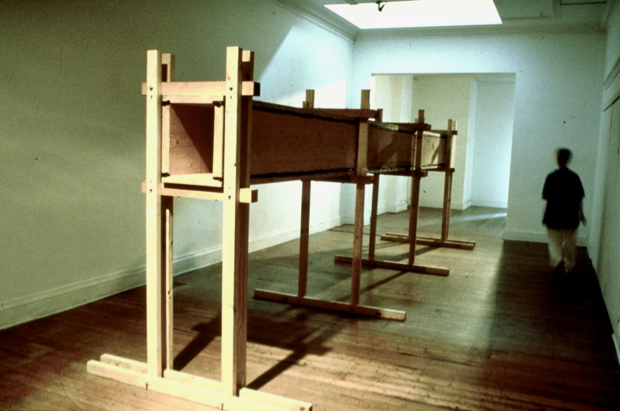
As an instrument tuned to a particular architectural envelope the work argued strongly for a sculptural practice which values the experiential mode over the representational mode, engaging the entire gamut of sensory functions. Through this kinaesthetic method the sonic form approaches the density of a sculptural material, and argues that the sonic mode, perhaps more convincingly than the visual, informs our sense of spatiality.
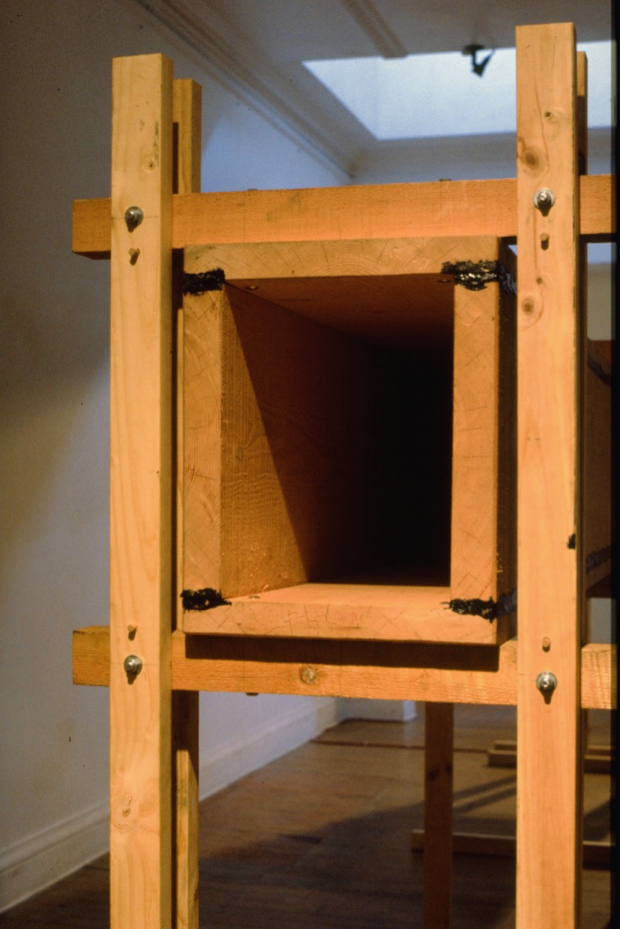
The following text, by Allan Vizents is extracted from the exhibition catalogue.
1. Standard Mechanism of Slippage.
The Professor Majerlowski is docked at the container terminal in White Bay. The watchdog spots me, scanning from behind a chain link fence and shifts into a long run toward the fence with German eyes, gaining speed, so I back off and the animal hits the fence barking.
The ground is wet from rain and the yellow/black fur is soaked and matted along the sides and belly. Everything has a picture, reports filter and focus, composed of detail close-ups and obscure long shots. The Australian foreign debt has passed 100 billion and Mexico comes into view through the chain links.
I am riding a third class carriage south of Vera Cruz in the night. The hills on both sides are sprinkled with small cooking fires, and in the distance the stars in the black mix with the orange burning of the hills. There are many fires, more than I would want to count.
I am, I feel, extremely ill as a nation, as a patient, and a traveller, I am in San Salvador, the capital of El Salvador, and can no longer eat. I am a consumer of cultures who cannot eat, the focus of another’s revenge. On a side street I walk into a banana warehouse. Mountains of colour pace the central aisle toward a nave of light at the distant end. Yellow, black, orange and green bananas tower like funerary mounds to a single banana at each peak. I am ill with the colour and quantity of this fruit. I can no longer eat baked banana, nor boiled, grilled, or the thin soup of banana.
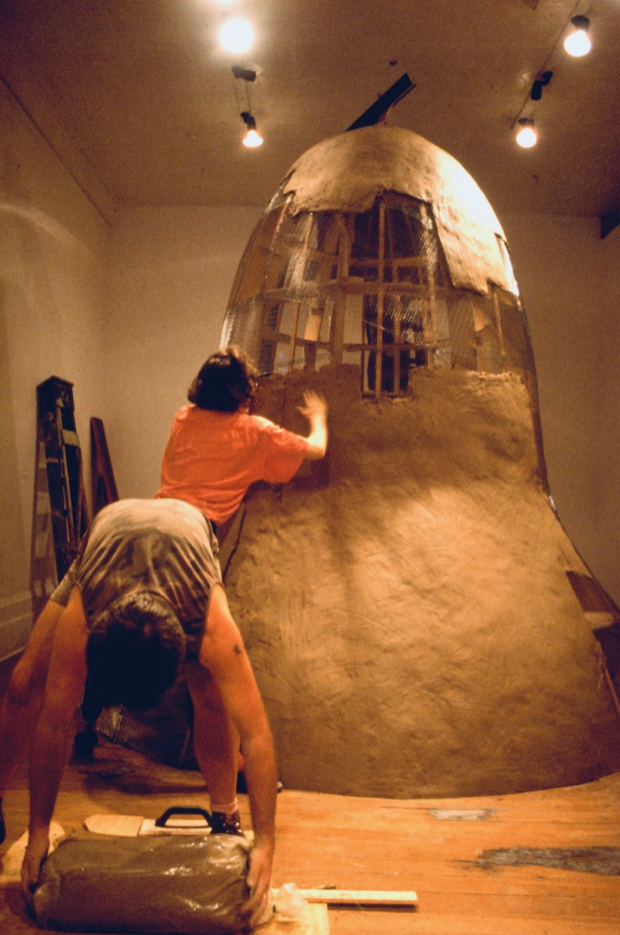
The dingo moves quickly in the fading light, desiring the child. A vast populism, like the image of ripe fruit, gathers noise in mortgaged nation, frantically kicking at the straws of its shredded mythology. Logophobia admires the shift from consuming products to consuming ideas, the new marketplace opened by advertising where banana charlatans hallucinate and shimmer in the warehouse, the container terminal and between satellite and dish. Mythologies sparkle like new fires in the hills.
I am sitting in the lounge room. The television is off; all stations are broadcasting a constant stream of rock video clips. Whose subject am I? I have torn open a package of Doritos Cornchips, with ‘creamy-herb flavour’. The taste has nothing to do with Mexico, except by a distant relation adulterated and chemically restructured by language. It is for dipping into Mexico, into culture, that I have been constructed as subject.
The relation is a video clip fired at a mirror and reflected from a distant receiving station, a global drone; white noise where consumption is inevitable, movement kept to a lounge room minimum and bodies are targeted from the hills, the hills of Mexico, among the banana plantations south of Vera Cruz.
Sydney is to Vera Cruz as one colonial port to another. Cortez landed there in 1519. In Vera Cruz the street trams, built in 1909, still grind through streets of Spanish colonial architecture. The tram windows are broken and smashed. In Sydney the architecture is modern colonial and the trains are slashed with knives and graffiti.
The movement at the station is digital. The Professor Majerlowski is docked in Vera Cruz, in Sydney in Cartegena; the Professor is docked and loaded. The ship to shore is rattled with static. The satellite image is impacted with atmospheric disturbance. Everything will clear except the oily seas washing the shores of the globe.
2. The Passage of Standard Slippage.
The captain and first officer are seated at the control panel and before them stretch the vast machinery of the factory. Digital readouts cast green light from the left and orange from the right. Below, on the factory floor, watchdogs patrol the convoluted passages deftly avoiding the mechanised robotics. In the ceiling, large windows open to the night sky, and from the control panel, a clear view of the Southern Cross is often maintained.
The air conditioning is superb.
The factory is located below the first deck of the ship, and produces multiple variations of desire during trans-oceanic journeys. The factory operates between cultures, as a neutral agent, a mythologising machine that refuses the notion of the irrational and/or schizophrenic. The machine can convert anything from raw emptiness to vast quantities of matter into meaningful patterns.
The ship is ancient. To some it has appeared as a canoe, and to others a ghostly windjammer without crew. It has made its appearance throughout human history in each and every (successive) act of perception by man. It channels and funnels meaning, appears as a power engendering device of repression, as a ship of state, as a subjective voyage of the individual, as sexuality.
The passage is to nowhere in particular as a passage can be a range of metaphoric ‘principles’. It is in one sense, an historical notion of technical development as ‘progress’. In another sense, the passage is that of material through mechanism, division, the discipline of man over matter and body. In a similar sense, the products or evidence of production, the small parts, the toy boats and guns fabricated are simply split-off from the primary mechanism and become other machines in the repetitive sub-mechanisms of desire. This is often extended to pieces that ‘come-apart’, sub-mechanisms made of transportable parts or sections, which can then be re-constructed and the process of desire relived as the joy of ‘putting it all back together’ by the consumer.
On one particular evening, the mammoth vessel was sighted near the equator. It appeared to be motionless, and the water itself parted and flowed past the stainless sides.
It can be the ship of state: we are standing on the coast, along the route of the condemned in transport. In contrast to those who are deeply offended, others are righteously pleased as one and the same mechanism crushes its intended victim. One and the same desire operates in a theatre of victory/defeat, signalled by the ancient columns that crack at the moment of impact and re-affirm the power of the desiring machine even as it deteriorates in time.
We are educated by our desiring machine. To use a rifle, a tongue, a toy pharmaceutical set, is a set of gestures choreographed in memory. The use of a battleship is another set of gestures inscribed by the military on the bodies of sailors. We desire that the performed event be perfect, achieve intended results. The empirical solution is one of re-enforcing gestural definition. Myths are continually reborn in such acts as they describe the process of our desire, and confirm its intended results.
One would expect such a ship and factory of desire to charm the viewer into submission with a sonic ring. Just such a call sign is repeated in perfect symmetry, recalling the re-enforcement of the project of power/knowledge by its many tools. Visually this call sign can appear as the static voyage, (the implied movement), the flow of material through the machine, the representation of the earth itself as the constellation is seen, or the sight of the sun and its loss from vision. The absurd or grandiose irony of our production and conflict lies in fascination with the call sign. We rattle the fetish chains of our subjugation. The flow of the interminable message, the single organ pipe, is caught (received), recorded and re-broadcast on our bodies. In each cycle the background adds its touch of white noise. We give to our neighbour our body social to hold in trust, the atoms of mis-representation, whirling and knocking as so many pinballs transcribed onto a video monitor. The nostalgia of the radio waits on the coastal shelf, confirming the passage of an old power changing faces once again.
The cycle of the call sign, the sonic beam, is the slippage of desire between dualities. The night train from Mexico City to Oxaca is a serpentine beam barrelling into the black and the south; fifteen hours across the plateau and down through the canyons.
There is a wooden floor covered with sleeping bodies, their feet blending with their shoes in a smooth blanket of dust. There are outlines of shoes and sandals pencilled in dust, but no material difference.
Downhill the canyon and the train swaying and bending, hands lifts baskets tied in twine, covered in flour sack and re-arrange their locations in constant measures of importance.
The cycle of the call sign, the standard slippage, is re-called by the arcing torch beam and the screaming brakes. As the locomotive twists to the right, the fire in the boiler becomes visible, and beyond, the silver light fanning the rocks and spines of dead trees.
3. The Morphology of Slippage.
The inner city property has been slowly removed from the asset register, sold for development into office blocks and residential towers. New highways are constructed with median dividers in plastic flora. A few acres remain of the old movie backlit, surrounded by chain link fence, and I have slipped through beneath, where the urban domestics have scraped their way in and out.
I am lying in the dry weeds near the Mexican village as a security guard approaches in an army jeep. I am next to the hull of a four meter replica; the battleship Saratoga. The small cannon are just over my head, also hidden by the weeds. The rear decks are partially destroyed, perhaps the result of a Kamikaze film sequence archivally maintained somewhere under controlled temperature and humidity.
I am beside myself with desire; with the Saratoga and the constant approach of danger. I dig my fingers into the clay and flatten one ear to the ground. I can just hear the sound track of a submarine’s sonar.
The lexicon of organ pipes is biomorphic; a dictionary of organic sound. A pipe is discussed by reference to its body, upper and lower lip, tongue and ear. It is nevertheless a mechanism driven by air pressure, a simulation of the body, a prop for the theatre of religion and a desiring mechanism. The pipe emits a call sign, sonar in a single note from tongue and lips through the body (which body) this body now horizontal in the gallery without weeds.
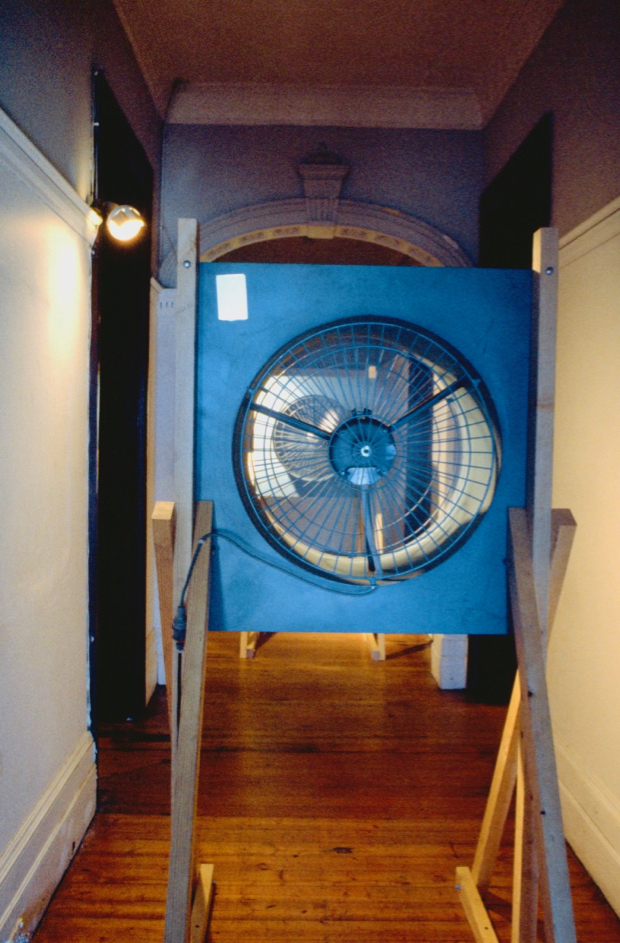
The village of Nebej is high in the mountains of Guatemala above Sacapulas. In the centre of the village is an adobe cathedral with a single tower rising to the bell platform. Each morning an Indian climbs the circular stairs and begins a symphony on the two bronze bells. The smaller is cracked and neither has a striker. He uses a wooden stick to play a complex of sonic patterns that weave into the echoes from the mountains. The tower walls are covered with pencilled poems. The poems describe a lover’s body.
A bell not yet a bell must be a manikin for a bell’s body, a clay memory of an adobe cathedral and a signal for what must eventually be a call sign and a discipline device. The bell has heralded the siren on the factory wall, the school and the prison. I hear a bell in every foghorn, auto horn, air raid and fire alarm. The telephone rings, the crossing gate falls, I am awakened, warned and informed as the sonar scans, scans by body, my social body, my physical world and the air sings with discipline as the atoms are constantly re-ordered.
A long rope has been stretched from the bell tower to the courtyard, where it is firmly staked. Small bags of gunpowder are fused and dropped into vertical pipes. A dry wind fans the smoke and paper shreds of many explosions. The noise is constant.
The rope passes through the clay body of a white horse mounted by a manikin of a Conquistador’s body. He and the horse are facing away from the bell tower and are pulled slowly backward, up the rope to the tower, but not quite reaching the bell before returning down the incline at the same measured pace. This celebration is slowly repeated through the day and re-cycled over the next three days. It is repeated each year and has come to be both expected and recalled.
© Allan Vizents 1987